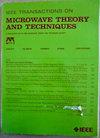Common-Mode Behavior Optimization for a D-Band Class-AB Power Amplifier Achieving 32 Gb/s in 22-nm CMOS FD-SOI
IF 4.1
1区 工程技术
Q2 ENGINEERING, ELECTRICAL & ELECTRONIC
IEEE Transactions on Microwave Theory and Techniques
Pub Date : 2025-02-05
DOI:10.1109/TMTT.2025.3533900
引用次数: 0
Abstract
This article presents a D-band (110–170 GHz) power amplifier (PA) for future 6G wireless infrastructure implemented using the 22-nm CMOS FD-SOI technology from GlobalFoundries. The design features a fully differential power combiner with extremely low insertion loss. The differential nature of the combiner, together with careful local bypass placing and sizing boost the common-mode-rejection-ratio (CMRR) of the output matching network (OMN), improving the power gain and output-referred 1-dB compression point (22nm CMOS FD-SOI中实现32gb /s的d波段ab类功率放大器的共模行为优化
本文介绍了一种d波段(110-170 GHz)功率放大器(PA),用于使用GlobalFoundries的22纳米CMOS FD-SOI技术实现的未来6G无线基础设施。该设计具有极低插入损耗的全差分功率组合器。组合器的差分特性,加上精心的局部旁路放置和尺寸调整,提高了输出匹配网络(OMN)的共模抑制比(CMRR),提高了放大器的功率增益和输出参考1 dB压缩点($\text {OP1}_{\text {dB}}$)。功率级偏置在深AB级,固有地增加了回退效率和$\text {OP1}_{\text {dB}}$,并级联到中等AB级增益级,以获得总体平坦增益响应。匹配网络使用堆叠变压器实现,也用于供电和偏置馈线。串联电阻放置在偏置线上,以稳定共模(CM)回路,并优化线性度。放大器的小信号增益为16 dB, 3db带宽(BW)以140 GHz为中心为21 GHz。$\text {OP1}_{\text {dB}}$为11.4 dBm,饱和输出功率(${P}_{\text {sat}}$)为14.6 dBm。最大功率附加效率(PAE)和6db回退PAE分别为10.6%和2.8%。采用无任何预失真的16-QAM信号,最高测量波特率为8 GB,数据速率为32 GB /s,平均输出功率和PAE分别为8.1 dBm和4.2%。
本文章由计算机程序翻译,如有差异,请以英文原文为准。
求助全文
约1分钟内获得全文
求助全文
来源期刊

IEEE Transactions on Microwave Theory and Techniques
工程技术-工程:电子与电气
CiteScore
8.60
自引率
18.60%
发文量
486
审稿时长
6 months
期刊介绍:
The IEEE Transactions on Microwave Theory and Techniques focuses on that part of engineering and theory associated with microwave/millimeter-wave components, devices, circuits, and systems involving the generation, modulation, demodulation, control, transmission, and detection of microwave signals. This includes scientific, technical, and industrial, activities. Microwave theory and techniques relates to electromagnetic waves usually in the frequency region between a few MHz and a THz; other spectral regions and wave types are included within the scope of the Society whenever basic microwave theory and techniques can yield useful results. Generally, this occurs in the theory of wave propagation in structures with dimensions comparable to a wavelength, and in the related techniques for analysis and design.
 求助内容:
求助内容: 应助结果提醒方式:
应助结果提醒方式:


